Everything you need to know about search engine optimization (SEO)
Here, you’ll find:
- How to define search engine optimization
- Why SEO is an important part of digital marketing
- What makes up a good SEO strategy
- SEO trends worth keeping an eye on
It’s no secret that, in today’s digital marketing landscape, it’s all about the search engine. Whether you rely on organic reach or leverage paid ads, getting on page 1 of the search engine results page (SERP) is always the goal.
But it doesn’t come easy. The algorithm changes often, and new competitors can crop up anytime. Having a site that’s optimized for search engines can be the game-changing factor that helps your brand stand out.
For the full 411 on SEO, let’s dive in.
What is SEO?
The point of SEO is to rank organically for relevant searches to your website without having to pay for ads. As we’ve mentioned before, following SEO best practices helps ensure your site is set up for success. These strategies also add value to your overall brand while showing prospects and users that your company is one they can trust.
One of the most effective SEO methods is to publish well-written, original content that can inform people or answer their questions. Unfortunately, SEO isn’t quite as simple as that. And just having quality content is only scratching the surface.
What is “the algorithm” and how does it affect SEO?
Google (along with all other search platforms such as Bing) has a search engine algorithm that takes hundreds to thousands of different aspects into consideration when a user enters keywords or a query.
That’s why, when we say “search engine optimization,” we’re talking about setting up your site to show search engines that your brand is relevant, trustworthy, and legitimate in relation to your industry.
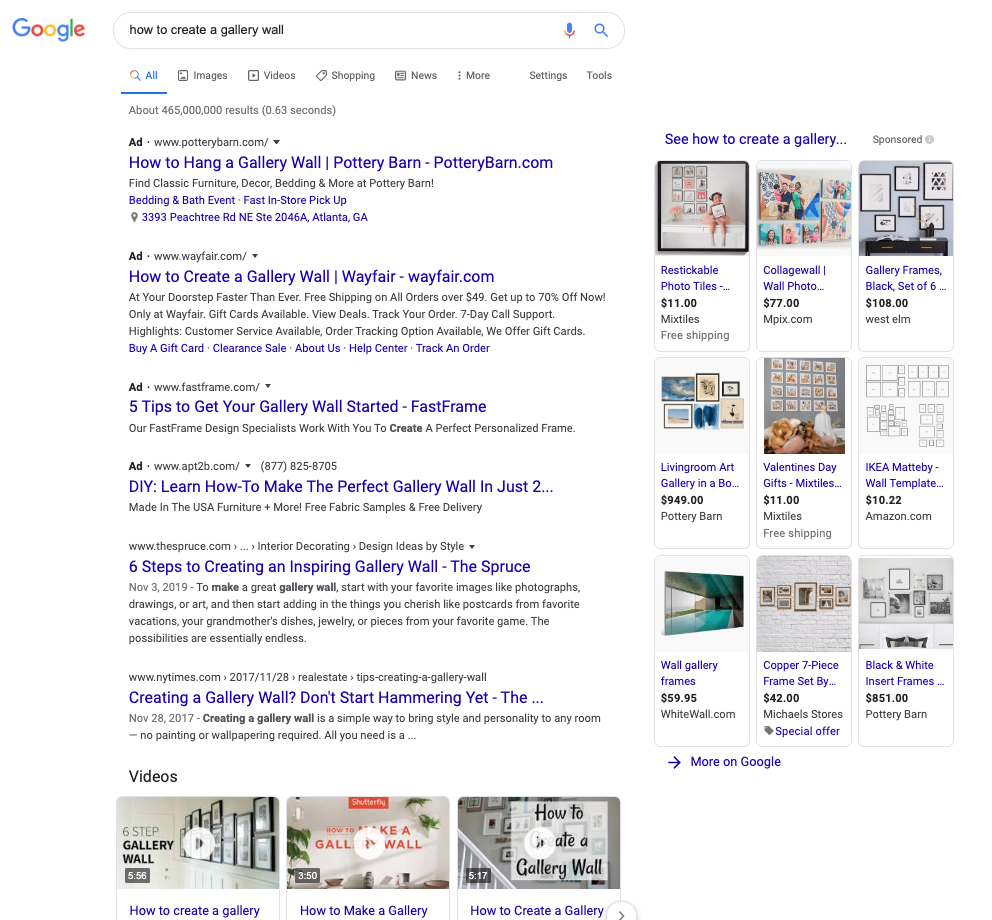
Here’s a look at paid and organic search results on the SERP for a query about creating a gallery wall.
You can learn about the process and guidelines Google adheres to make sure their algorithm “meet high standards of relevance and quality” here. However, search engines keep marketers on their toes by regularly rolling out tweaks and updates without much (or any) advanced notice.
Since it launched, Google has gone from making only a handful of algorithm updates every now and then to rolling out thousands of changes each year. These updates come with varying levels of impact on the search engine results page, or SERP, according to Search Engine Journal.
Because of this, it’s worth your time to focus on white-hat, long-game SEO techniques rather than trying to game the system through black-hat “quick wins.” The latter may get your site penalized down the line (more on that below).
Key factors that help determine which results will appear for your query are:
- Meaning of your query
- Relevance of web pages
- Content quality
- Usability of web pages
- Context and settings
How Core Web Vitals affect your SEO
In 2021, Google officially rolled out Core Web Vitals. Basically, this is a new set of ranking metrics that take things like speed, responsiveness and visual stability of pages on your site into account.
As the search engine itself explains, “the Core Web Vitals report shows how your pages perform, based on real world usage data (sometimes called field data).” Core Web Vitals are made up of three specific measurements: Largest Contentful Paint (loading), First Input Delay (interactivity), and Cumulative Layout Shift (visual stability).
Core Web Vitals are graded on a scale of pass, needs improvement, or fail. The way your site scores can impact how you’ll rank on the SERP.
Pro tip: As Google enhances its machine learning capabilities, Search Engine Journal advises marketers to keep “semantic SEO” in mind in 2021. Basically, this means choosing topics relevant to your audience, discerning searcher intent, and making your resource as rich and in-depth as possible.
How to start your SEO off on a clean slate
Whether your site is brand-now or has been around for a decade or more, it’s never too late to put good SEO practices in place. Even if everything looks fine and dandy, websites can have hidden technical SEO errors. These may not appear or be visible to the end user, but Google’s crawlers can detect it in the website’s code. Depending on the issue, this could cause your site to get penalized.
Put simply: If too many “red flags” exist on a site, Google will value it less than a competitor’s site. Because of this, your site may not rank well despite having original, informative, and high-quality content.
Other issues Google dings your site for include:
- 404 error pages (aka broken links)
- Missing or duplicate meta tags
- Pagination issues (such as too many indexable URLs)
- Thin content
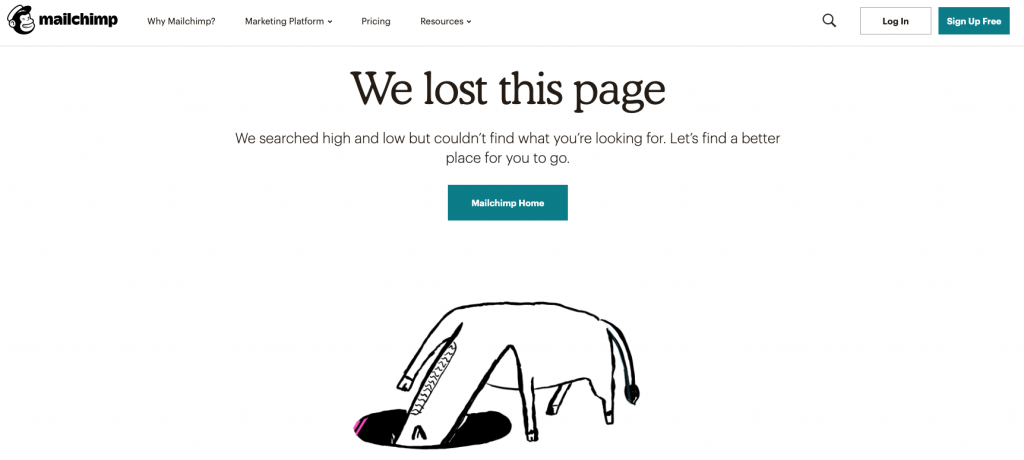
A 404 error page from Mailchimp.
To avoid Google undervaluing your site, making sure it’s “clean” is an important first step. Once you have a solid base to build off of, you can focus on content strategy and creation, links, schema markup, and other optimizations.
This stage can be time-consuming. You may want to look into having your developer crawl the site and conduct a wellness check or getting an SEO audit from a marketing agency.
Pro tip: Use this SEO-friendly website checklist for a quick-and-easy way to see how well your site is set up for organic search engine success.
Building an SEO-friendly website
A website with good SEO tactics in place often starts with proper site architecture. This refers to the way your site is structured, how users navigate it, and the ways pages are reached. The quicker and more straightforward your site navigation, the easier it’ll be for visitors to get the information they’re looking for.
Whether you’re launching a new website or redesigning an existing one, here are some SEO best practices to keep in mind:
- Test out new site elements on a staging site before pushing them live
- Implement redirects along with meta tags to avoid losing any SEO rankings you’ve already built up
- Update all buttons, logos, and forms
- Make sure there’s no duplicate content
SEO through quality content
Whether your business is e-commerce, financial services, or something in between, having well-written content on your site is beneficial for so many reasons. Not only does it strengthen your SEO, but it can educate your audience, show that you’re a thought leader in your industry, and help attract more visitors to your brand.
When you’re crafting a quality content marketing strategy, key steps include:
- Fleshing out your personas
- Defining your voice and tone
- Determining the keywords you want to cover through content
- Deciding the best brainstorming, writing, and editing process
- Prioritizing promotion
- Regularly analyzing performance
If you want your content to help boost your SEO, it’s important to pay attention to grammar and spelling. One way to think of it is: If an English teacher were to grade your website like a paper, would they give you an A, C, or an F? Google’s algorithm will read your content like an English teacher, and will also grade it (to a degree).
Tips for creating quality content
Once you’ve determined your relevant keywords and search terms, it’s time to work on creating the content. At the beginning of the writing process, think about how your content can answer questions of:
- Who
- What
- Where
- When
- Why

A content calendar example from a SaaS company.
Pro tip: When creating content, avoid keyword stuffing. This practice of over-inserting the keyword you’re trying to rank for is frowned upon. Plus, Google can recognize when someone is clearly mentioning a search term repeatedly and downgrade your ranking.
Once you feel confident about your content output and strategy, it’s wise to plan on regular content audits. This will allow you to identify old posts, high-performing pieces, and other content-related factors that will impact SEO.
Search engines favor new, robust content. By continuing to optimize pages, you can benefit from the long history attached to a URL while making sure the info on your site is timely, accurate, and up to date.
What are some stats on SEO?
- More than 51% of smartphone users have discovered a new company or product via a search on their smartphone.
- 72% of consumers say search is their first choice to find information on local merchants.
- Today, more people use search engines to find products or services than any other marketing channel.
- On average, B2B buyers conduct up to 12 searches before engaging with a brand.
- Google has more than 92% of the search engine market share worldwide.
- 61% of marketers say improving SEO and growing their organic presence is their top inbound marketing priority.
- 50% of search queries are four words or longer.
Metadata
As Moz explains, meta tags provide information about the webpage in its HTML. This info is dubbed “metadata.” While it’s not visible to your readers, it’s key nonetheless. Meta tags live in a page’s source code, and it’s used to tell search engines what a page is all about.
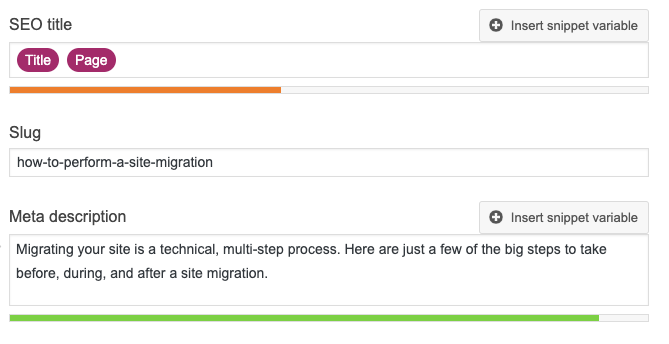
Here’s how meta titles and meta descriptions look when creating content about performing a site migration in WordPress with the Yoast SEO plugin.
Having pages with proper meta tags (which includes a title and description that accurately represent the page’s content) can impact not only the ranking of your page, but your clickthrough rate (CTR) and bounce rates as well.
When the preview for a page is accurate and lines up with the page’s content, those in search of what you’re offering already have a good idea of what they’re going to get from that particular page.
Pro tip: Make sure your site features an SEO-friendly blog by leveraging internal and external links, posting in an easily readable format, including a descriptive URL, and having designated keywords.
Header tags
No matter how high quality the content or well designed the page, if your site features large blocks of plain text, you’re in danger of having eyes glaze over and people bouncing from your page. Much like the metadata, header tags (the most common being H1, H2, and H3) serve as a kind of outline or table of contents for each page. See that “Header tags” line above? It’s an H3 header tag.
These tags also serve to emphasize what a paragraph or section will be about. This makes it easy for readers to scroll to the parts of your page that particularly interest them. Header tags are also tied to SEO. Search engines can weigh these headings and subheadings more than the paragraph copy in terms of importance.
If your blog title is H1, your headings are H2, and your subheadings are H3, they’ll be prioritized in that same order when it comes to the search engine. Also worth noting: While header tags extend to H6, most sites stick with H1-H3.
Pro tip: Another way to get an edge over your competition? Conduct a competitor analysis for SEO. Identify their ranking keywords, analyze their content and website, and check out their Google My Business page. This can help you pinpoint areas of weakness you may be able to capitalize on and more.
Backlinking
Linking is an incredibly important aspect to cultivating SEO that ranks you well. Having high-quality, highly relevant backlinks (links from another domain to yours) tells search engines that other sites trust yours, so end users probably can as well.
We’ve talked before about how more backlinks (also called inbound links) from credible sites help you rank higher on the SERP. Think of backlinks like endorsements. They’re used to let Google know your site is valuable and legitimate.
You can encourage backlinks to your site by:
- Publishing unique statistics, survey data, or other exclusive info
- Writing guest blogs or being quoted on other credible websites
- Partnering with influencers in your industry
- Reaching out directly to sites you want backlinks on
When it comes to reaching out, there’s no magic formula. And, like SEO itself, it takes time. Your best bet, when cold-emailing another brand to request a backlink, is to keep the message short, make it personalized, and highlight the benefit for their site, not yours.
For example, if you find a well-known industry site is using outdated stats or content that you happen to have an up-to-date version of, send it to them and see if they’ll replace the older link.
Disavowing links
Not all backlinks are good, however. Spammy or “toxic” backlinks can lower your site’s domain authority and your rating. In turn, this lowers how trustworthy your site appears. If there are a bunch of spammy sites linking to yours, Google will treat your site as a terrible one as well. Consider it a “guilty by association” mindset.
Luckily, there are steps you can take to prevent low-quality sites from tanking your SEO rep. Disavowing these toxic sites (which tells Google not to associate these links with your website) is key to maintaining a higher standing with Google.
While external linking is important, internal linking shouldn’t be overlooked. Linking from your own pages to other pages on your site is beneficial in Google’s eyes. It can also be helpful to the end user as well (which, really, is a big reason why search engines value internal links).
Pro tip: When it comes to disavowing backlinks, Google warns that this advanced feature should be used with caution. You only want to disavow links that are sure to reflect negatively on your site. “If used incorrectly,” Google explains, “this feature can potentially harm your site’s performance in Google’s search results.”
Schema markup, structured data & rich snippets
Schema is a structured data vocabulary created by the major search engines (Google, Bing, Yahoo!, and Yandex). Structured data is what helps these search engines better understand and define what a post or page is about.
This special language can be added to an HTML markup as code to enhance the snippets that appear below your content on the SERP. With schema markup, you can add elements like a publish date, event schedule, or product rating. It can improve your SEO and CTR by adding context to your pages, thus helping you rank better.
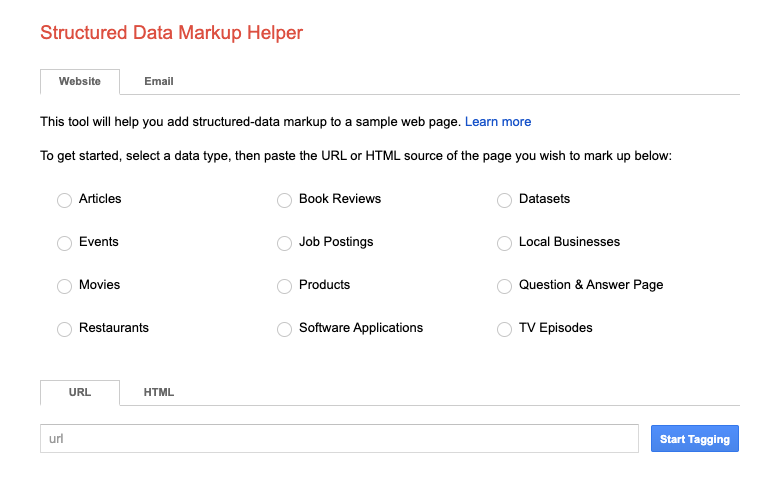
Google’s structured data markup helper tool.
This additional content is referred to as “rich snippets.” If a normal snippet merely includes the URL, title tag, and meta description, any additional info is considered a rich snippet.
You can add schema markup to your pages by visiting schema.org, selecting the type of markup that you want to use, and adding the code to your page. If you publish on a site like WordPress, you can add this data via plugins in a snap. Once added, you can test that the structured data was set up properly via Google’s structured data testing tool.
Pro tip: While adding structured data to your pages can boost SEO, adding it doesn’t guarantee that they will show up on the SERP, even if you’ve followed all of the steps correctly.
What is local SEO?
Local SEO leverages content to answer locally relevant or location-based searches. HubSpot defines local SEO as a way to help businesses “promote their products and services to local prospects and customers.
To gather information for local search, search engines rely on signals such as local content, social profile pages, links, and citations to provide the most relevant local results to the user.”
“Near me” searches, or searches based around a local city or region, are extremely popular these days. In fact, 80% of consumers use search for local information. However, location-based searches are treated slightly differently than a standard search. If you own a local business, have a local blog, et cetera, then you’ll want to keep local SEO in mind.
Optimize for Google My Business
One way to do this is by making sure your site is optimized for Google My Business (GMB). This search engine feature aims to show that a business is relevant and authentic. As a bonus, GMB-optimized businesses may show up as a pullout sidebar on the SERP, giving your biz that much more exposure.
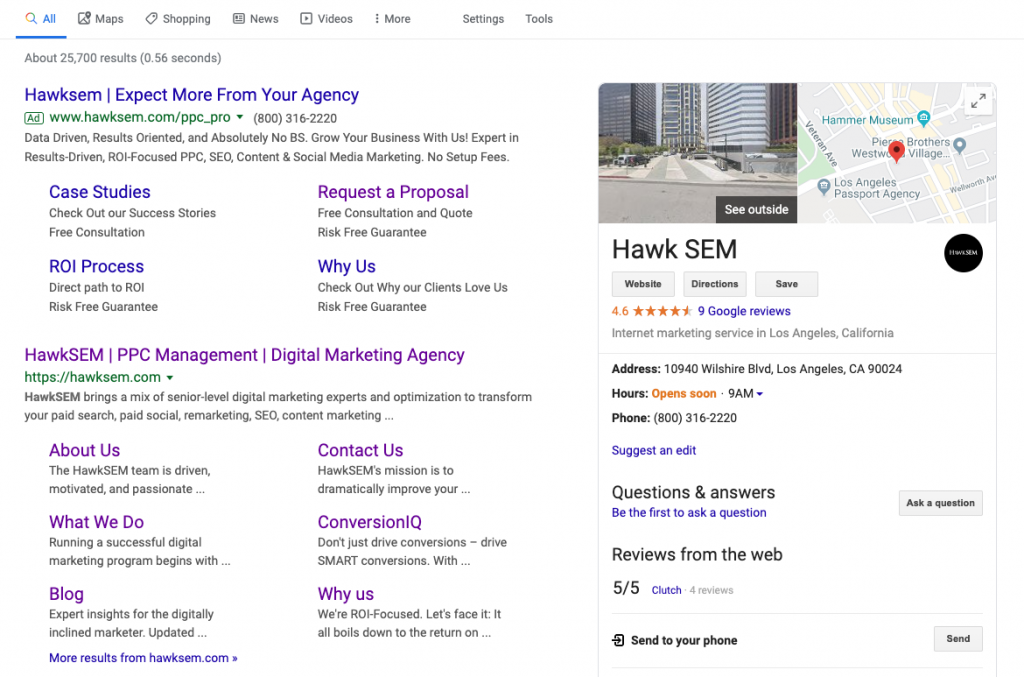
How HawkSEM’s Google My Business page looks on the SERP.
Optimizing for Google My Business entails:
- Creating a verified GMB page for your company
- Garnering authentic online reviews from customers
- Responding to these reviews using location-based info
- Using Google Posts in your account (which allow you to share news and messages on your GMB page)
Other ways to optimize for local SEO include publishing location-specific content, adding separate location pages to your site (if your brand has locations in multiple cities), and making sure your NAP (name, address, and phone number) info is consistent and accurate across the web.
Accelerated mobile pages
The majority of searches are now done on mobile devices. In fact, Google rolled out mobile-first indexing in the spring of 2018 to take precedence over its traditional desktop index. Because of this, it’s crucial for your SEO to make sure your entire site is mobile friendly.
Created by Google and Twitter, accelerated mobile pages (AMP) are a critical part of Google’s mobile approach. AMPs feature a more minimalist, stripped-down HTML version of a webpage for quick loading and easy access on mobile devices.
It’s up to you whether or not AMPs are worth it for your business. While they may receive a favorable ranking on the SERP, these pages often don’t have as many elements or designs as regular pages.
AMPs don’t appear to be going away anytime soon. That’s why it’s worth it to explore your options when it comes to enhancing your AMP content for Google Search and customizing these pages to fit your needs.
Important metrics
We often get asked what types of metrics or KPIs are most important to keep track of when it comes to SEO. In terms of core KPIs, we generally look at:
- Organic sessions
- Organic bounce rate
- Average page views per session
- Domain authority/rating
- The number of keywords or search terms ranking in the top 3 results (above the fold, first page)
- Keywords or search terms ranking on page 1 (in spaces 1-10)
- Keywords or search terms ranking in spaces 11-50
The metrics you look at and prioritize will depend on factors like your goals and how long you’ve been actively implementing your SEO strategy.
White hat vs. black hat SEO
“White hat” and “black hat” are SEO techniques marketers can leverage when optimizing a site. Basically, white hat SEO techniques are ethical, Google-approved methods that are looked favorably upon by search engines. White-hat techniques include publishing high-quality content that speaks to a human audience, implementing a long-term SEO strategy, and including alt tags with your images.
Black hat, on the other hand, refers to methods that attempt to trick search engines by making a site appear more legitimate than it is. These common SEO mistakes include keyword stuffing, creating blogs for the sole purpose of generating links to other sites, and hiding “invisible text” in the code of your website in an attempt to game the algorithm.
Black hat methods are frowned upon by search engines. While it’s not against the law to use them, they can get your site flagged for violating guidelines or prevented from appearing in search results entirely. Plus, black hat techniques often result in a poor user experience with your website.
Then there’s “grey hat” SEO. These are SEO methods that, while not currently against search engine guidelines, could become viewed as black hat in the future. This includes posting fake reviews, offering incentives for online reviews, and purchasing expired domains for the sole purpose of linking or redirecting to your site.
Pro tip: Looking for strategies to grow your organic traffic? We’ve got 14 right here.
How visuals enhance SEO
Speaking of alt tags, visuals are another important part of good site SEO. According to TechCrunch, 82% of all consumer IP traffic will be video in 2021. Not only that, but Search Engine Watch reports that video content has a 41% higher click-through rate than plain text.
If you have the bandwidth and budget, experimenting with video content could end up being what sets you apart from your competition on the SERP. Pages with videos are often visited for longer periods of time, and a longer visiting period can only mean good things when it comes to SEO.
In terms of photos, graphics, and other static imagery, Yoast explains that well-chosen images can complement your content and get you a good ranking in image search results.
“Alt tags” are alternative attributes on an image’s img tag. The purpose of this tag is to describe what the image is portraying, which not only helps the search engine understand the image, but it’s used as context for the visually impaired.
Depending on your website platform, it should be easy to add SEO-enhancing alt tags to your images as well as a title and meta description for your videos.
Pro tip: Videos can also be optimized by choosing an eye-catching thumbnail image, investing in paid ads for promotion, and adding captions.

Speed doesn’t just matter to users — it also matters to search engines.
Leverage SEO tools
Your search engine optimization maintenance doesn’t have to be a totally do-it-yourself process. Tools like Google Search Console and Bing Webmaster Tools help easily monitor how your site is currently performing on the respective search engines.
Once you set your site up on these platforms, you can view reports that’ll show you how your search performance is trending and more. They can also illuminate any issues that need fixing, like technical errors on your site that you may not be aware of.
Why is site speed important for SEO?
Site speed, especially on mobile, is another highly important aspect with regards to SEO. That’s partially because a site that takes even a few seconds to load can cause a significant number of visitors to immediately bounce.
But speed doesn’t just matter to users — it also matters to search engines. Google has been upfront for years about how page speed is a ranking factor for them (though, admittedly, not a hugely significant one). You can test out how speedy your pages are with Google’s PageSpeed Insights tool.
The takeaway
Search engine optimization is important when it comes to ranking on the SERP and growing your reach. But, at the end of the day, the goal of a search engine is to connect users with the answers they seek.
As long as you (or your chosen SEO agency) follow the above tips — and have a fast website with high-quality content that’s engaging, unique, current, and helpful — you’ll be well on your way to boasting successful, strong SEO.
This article has been updated and was originally published in January 2020.

